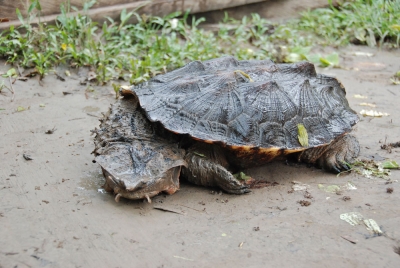
One of the matamata turtle’s most prominent features is its carapace, or shell. The carapace is not only large but also rough and knobby with what look like spherical cones projecting from it. These bumps are the result of three keels, or ridges, that run from the front to the back of the shell. The costal scutes — the scutes that run alongside those in the center of the shell — are conical with well-marked concentric growth rings.
The matamata turtle’s neck is wide, flattened and covered with warts, skin fringes and ridges. Its small eyes are nested at the sides of its large, flattened triangular head, and it has a wide mouth and long, tubular snout. That snout is used like a snorkel, minimizing the turtle’s movement as only the tip of the snout needs to emerge from the water for the turtle to breathe.
Matamatas have extremely poor eyesight, but a number of other sensory aids allow them to detect movements in the murky substrates they inhabit. Fleshy flaps extend from the sides of their triangular head, as well as along the neck, which is covered with bumps and ridges. Those skin flaps help camouflage the turtle and contain nerves that respond to stimuli, such as the vibrations caused by the nearby movement of potential prey. Tubercles near the corners of the mouth and neck, as well as barbels on the chin, also reportedly have sensory nerves. The turtle’s ears are large and extremely sensitive to sound.
Matmata turtles are found throughout the Amazon in northern South America, including Venezuela, Brazil, Peru, Ecuador, Colombia and Bolivia. They are also found on the island of Trinidad.
They are primarily aquatic and prefer the soft, muddy bottoms of slow-moving, shallow bodies of water, such as streams, swamps and marshes. They may also inhabit the brackish waters of the lower Amazon basin.
Credit : National Zoo
Picture Credit : Google




